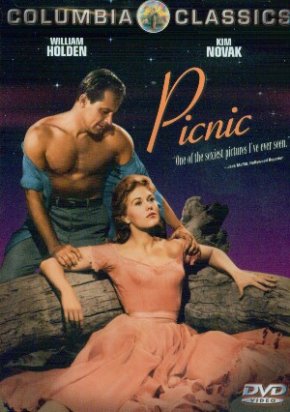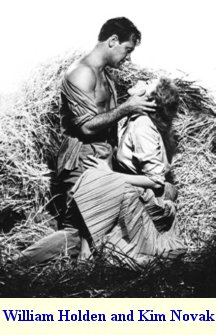|
JOHN STANLEY
Revisits 'Picnic'
The Sexiest Movie Alive In 1955!
By John Stanley
When I reported to you in my obituary-tribute to Hollywood composer George Duning that I was looking forward to seeing the brand-new DVD version of "Picnic" scheduled for release by Columbia Pictures, I had no idea what I was setting myself up for a short time later.
 I was making reference to the excellent soundtrack by Duning [April 7, 2000], which had earned him one of five Academy Award nominations during his fabulous career writing movie music. I was making reference to the excellent soundtrack by Duning [April 7, 2000], which had earned him one of five Academy Award nominations during his fabulous career writing movie music.
But when I finally saw "Picnic" for the first time in many years -- the first time in its original wide-screen CinemaScope format -- I suddenly realized it is one of the sexiest movies of its time, daringly slapping the Hollywood Code in the face, but in a very subtle fashion.
As for me finally getting wise to all this by watching the new Columbia DVD. . . talk about the awakening of a slumbering imbecile!
"Picnic," which did win Oscars for best editing and best art direction, was produced at a time when the morality code that controlled the content of movies was being defiantly challenged by a handful of liberal filmmakers. Chief among them was Otto Preminger, whose hatred of the code dated back to 1947, when a film he had directed called "Forever Amber" came under the fire of the morality watchdogs of Tinseltown. He wanted to stand firm and release the movie about 17th century debauchery exactly as he had made it, but his boss at 20th Century-Fox, Darryl F. Zanuck, cowed down to the board and made the cuts being demanded.
"Forever Amber," with Linda Darnell as the discarded mistress, was released in a truncated form, much to the anger of Preminger, who vowed that he would never again give in to censorship pressures under any circumstances.
The moment didn't come until 1953, after he had left Fox and stepped out on his own to produce movies independently. Preminger was one of the first established Hollywood directors to do so, at a time when it was difficult for independents to get ahead in the studio-dominated movie world. The movie he chose as his challenge of the Production Code seal of approval was "The Moon Is Blue," a William Holden comedy based on F. Hugh Herbert's Broadway hit. It dared to use such words as "virgin" and "pregnant" and "mistress" in its dialogue.
For Heaven's sake, how unforgivably salacious! While "Blue" seems tepid today and would be described as "bland" by today's hardened critics, it was an astoundingly controversial film in '53.
After being told by the morality gang to make cuts, and after the film had been condemned by the Catholic Church as a sinful viewing experience for any self-respecting Catholic, Preminger appealed to exhibitors across the country in thousands of letters that were dispersed to theater owners and managers. See the movie, make your own decision to book it or not book it, encouraged Preminger. After all, this is America. Why should someone else determine what you can play or not play, when you should have that right yourself.
Preminger's appeal to patriotism paid off. The exhibitors booked the film in abundance and it became a box-office smash. The rising young star of "The Moon Is Blue" was Maggie McNamara, who made only three more movies before she committed suicide in 1978. It jump-started the flagging career of British actor David Niven, and it upped the ante for its star, William Holden. At best, this film today is a "pleasant trifle." Its importance was in helping Preminger to be the first to defy and smash a piece of the code, which he continued to fight two years later in his daring drug-addiction film, "The Man With the Golden Arm." (This time the Catholic Church was smart enough to stay away from the controversy and decided to condemn nothing.)
"Picnic" was an equally daring film for Columbia to have tackled in 1955, being based on a popular, sex-charged Broadway drama by William Inge, himself a native of Independence,  Kansas, and hence someone who knew the people he was writing about firsthand. Also the author of "Come Back, Little Sheba" and "Bus Stop," Inge had picked up the Pulitzer Prize for "Picnic" because of his insightful look at the sexual repression of people living in a small Kansas town. Kansas, and hence someone who knew the people he was writing about firsthand. Also the author of "Come Back, Little Sheba" and "Bus Stop," Inge had picked up the Pulitzer Prize for "Picnic" because of his insightful look at the sexual repression of people living in a small Kansas town.
At the same time that it exposed hypocritical folks for what they were, it also featured a totally perverse ending: a young almost-virginal beauty runs away from home and family to follow after a no-good roaming bum who offers no prospects for her future whatsoever. Not your traditionally happy ending by any means, but a realistic one, depicting how normal people often behaved when they fell in love and didn't give a damn about anything else.
Most of Inge's plays were about unfulfilled people, and he himself would turn out to be his own most unforgettable character by committing suicide in 1973, after years of manic depression and an inability to write.
In contrast to the restrained sexual activities of the town's inhabitants, William Holden's performance as that no-good drifter Hal Carter, who hops off a freight train in the film's beginning minutes, is packed with sexual prowess and sexual tension. In many of the scenes he is stripped to the waist, and the lady folks in his vicinity are obviously impressed. It is this explosive sexual volcano of manhood that stirs up the emotions of the townspeople during the Labor Day picnic and finally has the film's three most important female characters throwing away their inhibitions and throwing themselves at Carter with the full force of their alluring femininity.
Oddly enough, one is aging, shrewish schoolmarm Rosemary Sidney played by Rosalind Russell, who was 47 at the time. Carter cares not a whit for her because he knows she sees through his facade faster than anyone else. She's a thorough hypocrite, criticizing others for carousing and drinking when she herself is the worst offender. In one scene, she sneaks a drink from a bottle of booze wrapped in a paper sack as she sinks down into the seat of a car driven by her nice-guy boyfriend, Howard Bevans (Arthur O'Connell).
The second is the town beauty, Madge Owens, played by a distractingly cool and sexy Kim Novak, who is definitely too young and undeserving of a low-down lowlife like Carter. The third is Millie Owens, Madge's tomboyish, awkward and frustrated teenage sister, played by Susan Strasberg in the only excellent role of her otherwise undistinguished film career. Brilliantly, Strasberg convinces you she's a boy-hater you would hate to be stuck with on a date. Then suddenly, when she dons a summer dress and heels and turns out for the picnic, she's a head-turning, attractive, mature young woman.
All this sexual awakening stuff as conceived by Inge is fascinating, but it's the direction of Josh Logan that brings the film to life in a way that only could be captured by a master filmmaker. In the way that he postures his actors in specific frames (with the help of cinematographer James Wong Howe), he suggests sexual acts in the most subtle of ways. Because I was only 15 when I first saw this film, I think I can be forgiven for not catching these erotic nuances.
Yes, I had also seen "Picnic" numerous times on TV in pan-and-scan versions, but unless you can see the full CinemaScope frames, and all the composition as Logan had intended it, you miss the full impact of these subtle sexual touches.
One of the more "subtle" scenes is with Rosalind Russell leaning against a tree in the park. Holden is standing across the frame from her, posturing in a manly way and walking about in the boots his father had given him. His crotch is in direct line with Russell's eyeline, and she doesn't hesitate to look directly at "it." The erotic look on her face, especially the hunger in her eyes, leaves no mistake about what kind of gratification she would love to be performing on Carter at that very moment.
A similar kind of scene poses the town beauty, Madge, sitting indolently in a swing as Carter hovers above her, leaning forward, his hands on the ropes. Madge glances hungrily if demurely toward his midsection, a reaction duly noted by her mother nearby.
Then there is the dance sequence between Carter and Madge, which became the most talked about movie event that year. Novak was still a relative newcomer to the screen, having been introduced just a year earlier opposite Fred MacMurray in a low-budget film noir thriller, "Pushover." Columbia kingpin and tyrannical boss Harry Cohn had intended Novak to be a threat to the uncooperative Rita Hayworth, but by 1955 comely Kim had grown bigger than anyone's replacement and was a sex symbol and rising star in her own right.
She had especially taken stage center with her pronouncement to the media that she preferred going braless, apparently allowing her body a sense of freedom that other women didn't enjoy  in the "bullet-bra" era of the 1950s. And there were plenty of cheesecake photographs around in '55 to prove that she practiced what she preached. This unique dress code enhanced her and set her apart from the other sex symbols of the day. in the "bullet-bra" era of the 1950s. And there were plenty of cheesecake photographs around in '55 to prove that she practiced what she preached. This unique dress code enhanced her and set her apart from the other sex symbols of the day.
"Picnic" was to be Novak's first important role, and it was to make her a star, soon followed by "The Man With the Golden Arm" and "Pal Joey.". As Madge, Novak sizzled sex all over the screen, her dreamy bedroom eyes hinting at the need for all kinds of foreplay and afterthoughts, her blonde hair and fair complexion radiating earthiness and aloofness, a sexy pink dress seeming to cling to every inch of her body, her breasts threatening to crash through and break out of the thin material that restrained them. She had to be one of the most desired women of her time, a soft bundle that would make any man forget his cares as he fell into her arms and was carried away on her gentle, caressing flesh.
The dance scene in the park pavilion that climaxes the Labor Day picnic -- and the word climax is not used loosely here -- is still considered one of the most sensuous sequences ever shot.
Putting aside the radiant image of Novak in her pink dress for but a moment, I would first like to concentrate on the remarkable performance of Holden, who was 37 at the time "Picnic" was cast. He admitted before filming began that he was too old for the part of Hal Carter, who had been written as a younger man by Inge. But Harry Cohn was smart enough to talk him into accepting the role. He was everything the role called for -- vulnerable, strong, weak, chauvinistic. Holden had the acting power to be chauvinistic and indifferent one moment, sensitive and caring the next. His true age never seems a relevant issue, to the story or to the casting.
Holden was desperately afraid of the dance scene, as he felt himself to be a poor dancer, as indeed he was. He complained so much about it that finally Logan, after the day's filming was done in Hutchinson, Kansas, took Holden to nearby roadhouses where the actor practiced his dancing to jukebox music with the picture's choreographer, Miriam Nelson.
Logan had wanted Novak to be the partner, but she would have nothing to do with the idea, preferring to spend much of her time in the local church, praying that she would become a star. She was generally reclusive during the shoot, taking her lunches and dinners alone, refusing to associate much with her co-stars. Always there was the church and the praying. You could almost hear her prayer: "Dear God, make me a great sexy movie star."
Logan kept scheduling the dance sequence for later, but finally ran out of other scenes to shoot and had to tell Holden he couldn't stall it off any longer. Holden turned chicken and refused to do the dance. It was only through the efforts of Cohn, and the promise of an additional $8,000 if he could perform the dance (offered to Holden in the form of a bet), that Holden finally faced the cameras and gave it his all. And all he did give.
It wasn't so much about all the footwork and fancy steps he had been worried about -- it was about the attitude, the sexuality behind the movements. Holden seemed finally to get what Logan wanted as the filming began and he moved slowly, deliberately, as if engaged in some erotic mating ritual. Then there was Novak in that damn pink dress, swaying slowly and seductively when she starts out to match Holden's slowness, sliding her hands together in a sensual clap, her eyes locked on his, his eyes locked on hers as if eye contact was how you physically performed sex.
It was really the work of Canton-born cinematographer James Wong Howe that determined the effectiveness of the dance. Howe kept the camera close to the players, from the waist up only, or in some shots from the shoulders up only, and he insisted that those eyelines never be broken. In one scene the lovers gaze deeply in a tight shot, the hanging Chinese lanterns behind them abuzz with moths.
The scene is as soft as Novak's mouth. Howe was a master with a camera, and one of the few directors of photography in Hollywood who was known to the movie-going public by name. Eight times nominated for his cinematography, and twice a winner of the Oscar (for "The Rose Tattoo" and "Hud"), Howe's eye for composition was exactly what Logan needed. They so complemented each other that it's surprising the film did not receive a nomination for the crisp cinematography that gave the film its needed Midwestern Americana touch.
About that music score: Duning blended his "Picnic" love theme with the popular song "Moonglow" as the dancers came closer and closer, still gazing lustfully into each other's eyes. Gradually the "Picnic" theme overwhelmed the "Moonglow" theme, a technique of counterpoint that brought praises from the music world. The Composers Guild of America called it "the best original underscore for a nonmusical film." The piece became so talked about it was released on a best-selling record that spent three months on "The Hit Parade" TV show. Later, an enthused Steve Allen was to write lyrics to the "Moonglow-Picnic" combination, creating another musical sensation when it also was released on record.
Some movies fail the test of time, and others get better with age. "Picnic" is a movie that has gotten better, especially when it can be seen in its pristine DVD format. And all for $14.97.
© 2000 by John Stanley
|
John Stanley
|
 |
JOHN STANLEY is the renowned "Creature Features" TV host and expert on horror, sci-fi and fantasy films whose Creature Features Movie Guide is now a standard resource for film buffs. He was a writer-editor for The San Francisco Chronicle for 33 years. Stanley wrote the novel World War III (1976), the Edgar-nominated mystery The Dark Side (1977), and the non-fiction book Them Ornery Mitchum Boys. Through his Creatures at Large publishing company, Stanley printed Robert Bloch's Lost in Time and Space with Lefty Feep (1987). He also wrote and directed the feature film "Nightmare in Blood" (1976). Since retiring from the Chronicle in 1993, Stanley has continued to review films, make crossword puzzles for TV Guide publications and work as an Elderhostel instructor, specializing in classes about the world of entertainment. In 2007, he provided the expert audio narration for Fox's "Island in the Sun" DVD and published his latest book, "I Was A TV Horror Movie Host." (This is an experpt from: http://www.thecolumnists.com/aboutus.html)
You can read more articles from John Stanley at: http://www.TheColumnists.com/stanley/archivestanley.html
Learn more about John Stanley by visiting his website at http://www.stanleybooks.net/
Mr. Stanley can be contacted at syndpack@aol.com or creature@netwiz.net
|